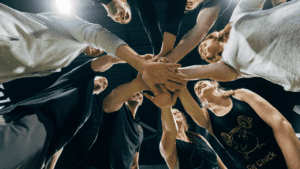There are so many misconceptions when it comes to building muscle; one of the biggest being that lifting heavy weights will make you bulky, which it won’t – that takes a great deal of time and a massive surplus of calories. Another common misconception is that you cannot build muscle without using weights. In fact, your bodyweight can help you build muscle!
Of course, if you are used to being in the gym and using heavy equipment, like barbells and dumbbells, it may feel a little strange to drop them. We definitely are not saying do not use weights anymore, but do not be misled by the common misconception that you can only build muscle with weights! Using your bodyweight only will allow many people to really slow down and focus on that mind to muscle connection that is needed to really push through workouts and see results. When dropping weights, you should increase your reps and slow down your tempo, holding and pausing at certain points – for example, hold a squat at the bottom of the squat before slowly coming back to starting position.
So, let’s look at how the body actually builds muscle. In order to increase your muscle mass, also known as hypertrophy, requires you to challenge your muscle and create more protein synthesis; the addition of new proteins within your muscles helps them to grow. There are actually three ways in which you can do this with exercise:
- Mechanical tension
- Metabolic stress
- Microtrauma
The majority of training regimes include all of the above, however, some workouts focus more on one than the other. We will now look at what each of these are and how you can achieve them in your workouts.
Mechanical Tension
Most of the time, you will experience mechanical tension while lifting weights. By loading the muscle with enough resistance in order to create tension, your cellular and molecular respond to this, which helps your muscles grow. By increasing your total volume, with additional reps and sets, you are able to then increase your mechanical tension. Slowing your tempo down also to create this tension as you move through each movement. Bodyweight exercises like push ups or pull ups are great at creating mechanical tension. Including exercises that you can gradually increase your total volume is proven to help with muscle gain.
Metabolic Stress
Do you ever get that burning feeling in your muscles when you have really worked hard and are struggling to get to the end of your set? For example, when you have done bicep curls for several sets, and by the last set begin to notice your bicep muscle burning as you lift the weight? This burning sensation you feel is a result of metabolic stress. Lactic acid builds up in your muscles as you work through each movement, and the more it builds, the greater this burn. There are quite a few reactions that occur within your body – including hormonal, cellular and growth reactions – when you experience metabolic stress. As a result, cells in your muscles swell and promote growth of your muscle proteins, thus bringing about tissue growth – aka gains!
Microtrauma
Lifting weights and other forms of resistance training can create tears in your muscle tissues; your body responds to this by attempting to fix these tears, which initiates muscle growth. By increasing weight or trying out new movements, you can help create microtrauma.
So, how can you make the most out of your bodyweight workouts to ensure you are building muscle? Check out our tips below:
- Increase the number of reps and sets that you perform, thus increasing the metabolic stress you experience. It is also important to decrease your rest time. In fact, research has indicated that this increase in reps and sets combined with less rest time can actually increase your muscle mass more than what it can when lifting heavier weights and resting for longer.
- Adjust your tempo by slowing it down, which creates more time under tension. The more time spent under tension, the more likely it is that you will experience microtrauma. Another great tip to try is to adjust the angle at which you perform movements. For example, create elevation for your squats, either by stacking plates on top of each other or using a block.
- Make use of pauses. Pausing creates more metabolic stress because the muscle is spending more time under tension – which also creates more microtrauma. For example, when executing a glute bridge, pause at the top and squeeze your glutes for a few seconds before returning to the starting position.
Do remember, by repeating the same circuits or routines over and over will stop bringing about results at some point. This is because your muscles will stop being challenged and you are likely to experience a plateau. It is important to switch up your routines periodically to ensure you are always being challenged, helping to promote muscle growth.
Want to learn more about working out and being healthy? Read more in our blog.




